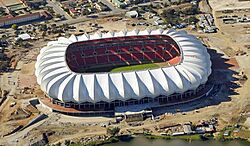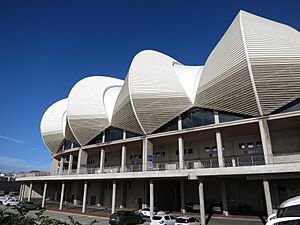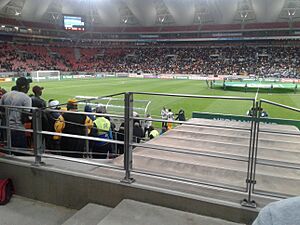Nelson Mandela Bay Stadium facts for kids
|
The Protea
|
|

Aerial view of the stadium
|
|
| Full name | Nelson Mandela Bay Stadium |
|---|---|
| Location | 70 Prince Alfred Road North End Gqeberha South Africa |
| Coordinates | 33°56′16″S 25°35′56″E / 33.93778°S 25.59889°E |
| Public transit | North End station (Metrorail) |
| Owner | Nelson Mandela Metropolitan Municipality |
| Operator | Access Facilities and Leisure Management (Pty) Limited |
| Capacity | 42,486 (2010 FIFA World Cup) 46,000 (Soccer and Rugby) |
| Field size | Soccer – 105m x 68m Rugby – 125m x 70m |
| Surface | Desso GrassMaster (2010–present) Grass (2009–2010) |
| Construction | |
| Built | 2007–2009 |
| Opened | 6 June 2009 (first event) 16 June 2009 (first match) 28 February 2010 (official opening) |
| Expanded | 2009 |
| Construction cost | Rand 2.05 billion (USD $ 270 million) |
| Architect | Architectural Design Associates(Pty)Ltd & Dominic Bonnesse Architects cc |
| Builder | Grinaker-LTA, Interbeton & Ibhayi JV |
| Tenants | |
| Chippa United (PSL) (2014–present) Eastern Province Elephants (Currie Cup) (2010–) Southern Kings (Pro14) (2013–2020) South Africa Sevens (2011–2014) |
|
The Nelson Mandela Bay Stadium is a cool place in Gqeberha, South Africa, where people play soccer and rugby union. It's famous for hosting games during the 2010 FIFA World Cup, including the match for third place! Today, it's the home stadium for the Chippa United soccer team.
This amazing stadium cost about R2 billion (that's a lot of money!) and was built right by the North End Lake. It was one of three new stadiums built along the coast for the 2010 FIFA World Cup. The stadium often hosts big soccer and rugby games, and sometimes even concerts!
Contents
Stadium History: How it Began
Before this stadium, the city of Port Elizabeth didn't have a big soccer field. Soccer wasn't given much support in the past. So, big soccer games often happened at the EPRU Stadium, which was mainly for rugby. This meant the grass wasn't always perfect for soccer.
When Port Elizabeth was chosen to host World Cup games, they decided to build a brand new stadium instead of fixing up the old rugby one. The old stadium would have needed too many changes to meet FIFA rules. So, they built this awesome, multi-purpose stadium!
The Nelson Mandela Bay Stadium was the first of five new stadiums to start being built for the 2010 FIFA World Cup. The other new stadiums were in Cape Town, Durban, Polokwane, and Nelspruit. All the World Cup stadiums had to be ready by January 2010.
Why the Name Nelson Mandela Bay?
The stadium is named after the area it's in, the Nelson Mandela Bay Metropolitan Municipality. This area itself is named after Nelson Mandela (1918–2013), who was a very important former President of South Africa. The Nelson Mandela Bay area includes Port Elizabeth, Uitenhage, Despatch, and other smaller towns.
Sometimes, people mistakenly call it the 'Nelson Mandela Stadium'. But there's already a Nelson Mandela Stadium in Uganda! It's good to remember that this stadium is named after the whole metropolitan area, not directly after Nelson Mandela himself.
Stadium Design: A Flower on the Lake
The stadium's design was inspired by a winning idea from students at Holy Cross High School in 2006. Their concept was reviewed by government officials and became the basis for the stadium's look.
The stadium has a special roof that looks like a flower with white 'petals'. This is why its nickname is The Protea, named after South Africa's national flower! The building is about 40 meters tall and has many levels. The main design work was done by Architectural Design Associates(Pty)Ltd and Dominic Bonnesse Architects cc.
There are three main gates to enter the stadium: Gate A-B on Milner Avenue, Gate B-C on Prince Alfred Road, and Gate C-D on Fettes Road. The western side of the stadium faces the North End Lake.
Cool Features Inside
The stadium can hold 46,000 people for soccer and rugby games. For the 2010 FIFA World Cup, they even added 4,000 extra seats! The seats are different shades of orange and red. This makes the stadium look full all the time and helps hide any sun damage or replaced seats.
The stadium has special rooms for important guests, business meetings, and even a gym! There are also two conference rooms that can hold 200 people.
It's easy to get around with four ramps for wheelchairs and several lifts for VIPs and staff. There are 32 turnstiles to help people get to their seats quickly. Two large screens (12.7m x 7.2m) show all the action on the field. Plus, there are 74 toilet blocks, so you won't have to wait long!
The Playing Field
The grass on the field was grown somewhere else and then brought to the stadium. The areas around the main field are made of artificial turf. For the 2010 FIFA World Cup, the field was all rye grass.
After the World Cup, a special system called Desso GrassMaster was put in. This helps the grass stay strong because both soccer and rugby are played there often. A team of five people works hard day and night to keep the field in top shape. They even use a special lighting system with powerful bulbs to help the grass grow evenly, especially in shady spots under the roof.
For soccer, the field is 105 meters long and 68 meters wide, which is approved by FIFA. For rugby, it's 100 meters long and 70 meters wide, with extra 'in-goal areas' behind the posts.
Building the Stadium
The stadium was built by a group of companies called Ibhayi JV. It was constructed where the old Parks Rugby Club and Prince Alfred Park used to be.
The roof is made of strong materials like aluminum and a special fabric called polytetrafluoroethylene (PTFE), supported by a steel frame. An Australian company helped put this unique roof together. A lot of digging and building went into making the stadium, with 21,000 meters of piles installed and 138,000 cubic meters of material dug out.
Building the stadium helped local businesses and created many jobs. About 6,800 jobs were made during the construction. It also helped improve the area around the stadium, bringing new life to the North End neighborhood. Everyone hoped the stadium would bring great opportunities for the city, both during and after the World Cup.
How the Stadium Was Paid For
The stadium cost about R2.1 billion to build. The city of Port Elizabeth, the provincial government, and the national government all helped pay for it.
The stadium's running costs are about R18 million each year. The company that manages the stadium hoped to cover its costs by 2012.
After the World Cup
The Nelson Mandela Bay Stadium is now the home ground for the EP Kings rugby team, the Southern Kings rugby team, and the Chippa United soccer team.
The stadium has also hosted big international matches for the Springboks (South Africa's national rugby team) and Bafana Bafana (South Africa's national soccer team). In 2011, it hosted a Tri Nations rugby match between the Springboks and New Zealand.
The stadium also hosted the South African part of the IRB Sevens World Series rugby tournament from 2011 to 2014. It was also one of the places where games were played for the 2013 Africa Cup of Nations soccer tournament. South Africa might even use the stadium in future bids to host the Rugby World Cup.
Getting to the Stadium
The stadium is located along the city's new BRT bus network. Special bus lanes have been built to make it easy for people to get to and from the stadium on game days. There will be bus routes from the airport, fan park, and the beach.
There are also 'park and ride' areas where you can leave your car and take a bus. These are at King's Beach, St George's Park, and Andrew Rabie High School. You can also 'park and walk' from Cilliè High School and Dr Viljoen Primary School. On match days, you can even take a train to the North End train station, which is about 1.3 km from the stadium.
While the full bus network is still being finished, temporary bus stops are used on game days to help people get around.
Stadium Area Park
Inside the stadium area, there's a park that used to be part of the old Prince Alfred Park. This park is sometimes used for smaller outdoor concerts.
Big Games and Events at the Stadium
2010 FIFA World Cup Matches
The stadium hosted eight exciting games during the 2010 FIFA World Cup. This included five group games, a round of 16 game, a quarterfinal, and the match for 3rd and 4th place.
| Date | Time (UTC+2) | Team #1 | Result | Team #2 | Round | Attendance |
|---|---|---|---|---|---|---|
| 12 June 2010 | 13:30 | 2–0 | Group B | 31,513 | ||
| 15 June 2010 | 16:00 | 0–0 | Group G | 37,034 | ||
| 18 June 2010 | 13:30 | 0–1 | Group D | 38,294 | ||
| 21 June 2010 | 16:00 | 1–0 | Group H | 34,872 | ||
| 23 June 2010 | 16:00 | 0–1 | Group C | 36,893 | ||
| 26 June 2010 | 16:00 | 2–1 | Round of 16 | 30,597 | ||
| 2 July 2010 | 16:00 | 2–1 | Quarter Finals | 40,186 | ||
| 7 July 2010 | 20:30 | 2–3 | 3rd-place play-off | 36,254 |
2013 Africa Cup of Nations Matches
The stadium also hosted eight games during the 2013 Africa Cup of Nations tournament. This included six group games, a quarterfinal, and the match for 3rd and 4th place.
| Date | Time (UTC+2) | Team #1 | Result | Team #2 | Round | Attendance |
|---|---|---|---|---|---|---|
| 20 January 2013 | 17:00 | 2–2 | Group B | 7,000 | ||
| 20:00 | 1–0 | 20,000 | ||||
| 24 January 2013 | 17:00 | 1–0 | 8,000 | |||
| 20:00 | 0–0 | 12,000 | ||||
| 27 January 2013 | 19:00 | 2–1 | Group A | 20,000 | ||
| 28 January 2013 | 19:00 | 0–3 | Group B | 10,000 | ||
| 2 February 2013 | 17:00 | 2–0 | Quarter Finals | 8,000 | ||
| 8 February 2013 | 20:00 | 3–1 | 3rd/4th-place play-off | 6,000 |
Soccer at the Stadium
The local soccer association, SAFA, has its main office at the stadium.
The stadium is the home field for Premier Soccer League club, Chippa United F.C., since the 2014–15 season.
In July 2009, the stadium hosted the Premier's Cup, with teams like Supersport United and Kaizer Chiefs playing. 20,000 fans came to watch!
Later that month, 30,000 fans watched Orlando Pirates play Kaizer Chiefs in the 2009 Vodacom Challenge. Kaizer Chiefs won after a penalty shootout.
On Women's Day in South Africa (August 9, 2009), a special day of games was held. It included women's teams and a match between Brazilian and South African soccer legends. The Brazilian team had players from their 1994 FIFA World Cup winning squad, and the South African team had players from their 1996 African Cup of Nations winning team.
The stadium hosted its first international soccer match on November 14, 2009. Bafana Bafana played Japan in a friendly game, which ended in a 0–0 draw with 44,000 fans watching.
The first Premier Soccer League game at the stadium was on November 20, 2009. Santos played Kaizer Chiefs, and 20,000 people saw Kaizer Chiefs win 1–0.
The stadium also hosted a friendly match between local team Bay United and the South Korea team in January 2010. South Korea won 3–1.
In February 2010, Orlando Pirates played Gaborone United in a CAF Champions League game. This match was also part of the stadium's official opening ceremony, which included music, a junior football match, and the unveiling of a special plaque.
In 2011, the stadium hosted the Nelson Mandela Challenge, an international friendly match between Bafana Bafana and Ivory Coast.
Rugby at the Stadium
The Eastern Province Rugby Union moved its main office to the Nelson Mandela Bay Stadium after the 2010 FIFA World Cup. They now play most of their Currie Cup and Vodacom Cup matches there.
On June 16, 2009, the stadium hosted a tour match between the British & Irish Lions and the new Southern Kings team. Over 35,000 fans watched the Lions win 20–8.
The Mighty Elephants (now Eastern Province Kings) played their first Currie Cup First Division game at the stadium on September 19, 2009, beating the Falcons 44–8.
In January 2010, the stadium hosted a Super 14 warm-up match between the Cheetahs and an Eastern Province invitational team. 15,000 people watched the Cheetahs win 13–9.
In October 2010, a new stadium attendance record was set with 45,000 fans watching the Eastern Province Kings play the Pumas in a Currie Cup match.
The stadium became the new home for the country's leg of the annual IRB Sevens World Series rugby tournament starting in the 2011–12 season.
The stadium has hosted several international rugby test matches. In August 2011, South Africa played New Zealand. In June 2012, South Africa played England, which ended in a 14-all draw with 45,000 fans. In June 2014, South Africa easily beat Scotland 55-6.
Concerts and Other Fun Events
The stadium has also been a venue for concerts and other big events.
Neil Diamond performed at the stadium in April 2011 as part of his first tour to South Africa.
In May 2011, the Nelson Mandela Bay International Music Festival brought top South African artists like Loyiso Bala and Hugh Masekela, along with the legendary George Benson, to the stage.
In December 2011, about 7,000 people enjoyed the beautiful music of Josh Groban at the stadium's Prince Alfred Park.
Other Big Events
On June 6, 2009, an open day was held for everyone in the city to see the new stadium. About 17,000 people came to explore the venue.
The stadium hosted the Miss World Sports event for the Miss World 2009 pageant in November 2009.
In March 2010, a group of South African churches held a mass prayer around the stadium. They prayed for blessings on the stadium and the 2010 FIFA World Cup.
In October 2010, there was an attempt to set a world record for the most women in bikinis in one place to help the Cancer Association of South Africa. While they didn't break that record, they did set records for the largest bikini and swimwear parades!
Isuzu South Africa used the stadium in April 2022 to launch their new Isuzu D-MAX vehicle.
See also
 In Spanish: Estadio Nelson Mandela Bay para niños
In Spanish: Estadio Nelson Mandela Bay para niños
- List of stadiums in South Africa



